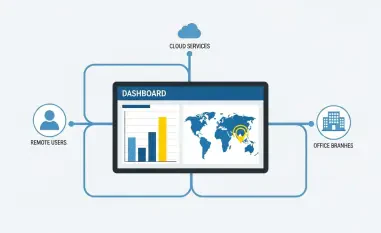As digital landscapes evolve at a breakneck pace, system administrators (SysAdmins) stand as the unsung guardians of organizational security, a role celebrated annually on SysAdmin Day, July 25th. Their responsibility to protect critical systems and data has never been more vital, especially in the Asia-Pacific (APAC) region, where rapid digital transformation collides with escalating cybersecurity threats. Privileged Access Management (PAM) emerges as a cornerstone in this battle, ensuring that access to sensitive systems remains secure amid cloud migrations, hybrid work setups, and sophisticated attacks. This analysis delves into the current trends shaping PAM adoption in APAC, the pressing challenges organizations face, expert perspectives on its strategic importance, and a forward-looking view on how it might redefine cybersecurity in the region, alongside practical insights for implementation.
The Rising Significance of PAM in APAC
Adoption Patterns and Regional Nuances
The surge in PAM adoption across APAC reflects the region’s aggressive push toward digitalization, with businesses increasingly migrating to cloud platforms and embracing hybrid work models. Industry reports indicate that cybersecurity investments in APAC have grown substantially over recent years, with a projected increase in spending on access management solutions by over 15% annually from the current year to 2027. This growth is driven by the need to secure expanding digital footprints, though it is tempered by varying levels of cybersecurity maturity and a complex web of local and international regulations that differ across countries.
Diverse market dynamics further complicate the landscape. Mature markets like Singapore and Australia often lead in adopting advanced PAM tools, while emerging economies grapple with legacy systems and limited resources. The shift to remote work has also amplified the demand for robust access controls, as organizations strive to manage distributed workforces without compromising security. These factors collectively underscore why PAM is becoming a non-negotiable element of cybersecurity strategies in the region.
Practical Implementations and Case Examples
Real-world scenarios in APAC highlight the critical need for effective PAM. Many organizations have faced severe data breaches stemming from poorly managed privileged accounts, such as incidents where attackers exploited admin credentials to infiltrate networks. A notable pattern involves ransomware attacks targeting high-level access points, crippling operations and leading to significant financial losses across sectors like finance and manufacturing.
Consider a hypothetical case of a multinational corporation headquartered in Jakarta, operating across multiple cloud environments. Initially lacking centralized access controls, the company suffered a breach due to shared credentials among third-party vendors. By implementing a PAM solution with real-time monitoring and temporary access protocols, it drastically reduced unauthorized access risks, safeguarded sensitive data, and improved compliance with regional data protection laws. Such examples illustrate how targeted PAM strategies can transform vulnerabilities into fortified defenses.
Core Challenges and Effective Responses for PAM in APAC
Pinpointing Major Obstacles
One of the foremost hurdles in APAC is the pervasive lack of visibility into who holds privileged access and how it is utilized. Without clear oversight, organizations remain exposed to internal misuse and external threats. This issue is compounded by inconsistent access policies, where over-permissioned accounts create unnecessary risks, particularly in sprawling multi-cloud setups common in the region.
Additional pain points include weak password practices, often involving reused or insecurely stored credentials, and limited session monitoring, which hinders timely detection of suspicious activities. Unsecured third-party access poses another significant threat, as vendors with temporary privileges can inadvertently become entry points for attackers. The region’s intricate infrastructure and diverse regulatory demands further intensify these challenges, making uniform implementation a daunting task.
Scalability remains a concern as well, with many legacy PAM tools struggling to adapt to modern, cloud-first architectures. Ineffective incident response plans also leave organizations vulnerable during critical breaches. These multifaceted issues demand a strategic approach tailored to APAC’s unique environment, balancing rapid growth with robust security measures.
Actionable Approaches for SysAdmins and CISOs
Addressing these challenges requires a suite of practical solutions, starting with the deployment of centralized PAM platforms that provide comprehensive visibility and control. Adopting the Principle of Least Privilege (PoLP) ensures users only access what is necessary for their roles, while Just-in-Time (JIT) access minimizes standing privileges by granting temporary permissions as needed. Multi-Factor Authentication (MFA) adds a vital layer of defense against credential theft.
Session recording and integration with Security Information and Event Management (SIEM) systems enable real-time anomaly detection and swift incident response. For third-party access, strict time-bound rules and automated expiration of credentials prevent lingering vulnerabilities. Scalable PAM tools designed for hybrid and multi-cloud environments are essential to support organizational growth without compromising security.
Tailored incident response plans specific to privileged access misuse are equally critical. Regular testing of these plans, combined with detailed access logs, ensures readiness for potential breaches and aids compliance efforts. By leveraging modern tools and customized strategies, SysAdmins and CISOs can effectively navigate APAC’s complex security landscape and fortify their defenses.
Expert Perspectives on PAM’s Strategic Value
Insights from industry leaders emphasize PAM’s indispensable role in modern cybersecurity frameworks. Takanori Nishiyama, Senior Vice President of APAC Sales at Keeper Security, highlights that prioritizing PAM is not merely a technical necessity but a business imperative. According to Nishiyama, robust PAM strategies are crucial for closing security gaps that threaten organizational integrity, especially in a region as dynamic and vulnerable as APAC.
Experts also point out that PAM serves as a linchpin for regulatory compliance, helping organizations meet stringent data protection mandates across diverse jurisdictions. Beyond compliance, it acts as a bulwark against sophisticated threats like insider attacks and advanced persistent threats (APTs). These perspectives reinforce the notion that investing in PAM is a proactive step toward building resilient cybersecurity postures in APAC’s high-stakes environment.
The Evolving Horizon of Privileged Access Management in APAC
Looking ahead, PAM is poised to undergo significant advancements with the integration of artificial intelligence (AI) for threat detection and automation of access controls. AI-driven systems can predict and mitigate risks by analyzing patterns in user behavior, while automated workflows streamline access provisioning and reduce human error. Integration with broader identity management systems promises a more cohesive approach to security.
These innovations offer substantial benefits, including a stronger security posture and enhanced compliance with evolving regulations. However, challenges such as high implementation costs, skill shortages among IT teams, and the need to keep pace with emerging threats could impede progress. Organizations must balance these hurdles with the long-term advantages of adopting cutting-edge PAM solutions.
Across industries in APAC, from banking to healthcare, PAM is likely to shape cybersecurity strategies by embedding security into digital transformation initiatives. While optimism surrounds its potential to revolutionize access management, caution is warranted regarding the complexities of deployment and the need for continuous adaptation. The trajectory of PAM suggests a transformative impact, provided organizations commit to overcoming initial barriers.
Securing Tomorrow with PAM
Reflecting on the journey, the exploration of Privileged Access Management in APAC revealed its escalating importance amid rapid digital growth and mounting cyber risks. Challenges like visibility gaps and regulatory complexities tested organizational resilience, yet actionable strategies such as centralized platforms and JIT access provided robust countermeasures. Expert insights underscored PAM’s strategic necessity, while future innovations hinted at a fortified cybersecurity landscape.
Moving forward, organizations across the region are encouraged to prioritize investments in modern PAM tools as a foundational step toward safeguarding critical assets. SysAdmins and CISOs play a pivotal role in driving this shift, advocating for secure access practices as a core business priority. The path ahead demands not just adoption, but a sustained commitment to evolving PAM capabilities to outpace emerging threats and secure long-term stability.













